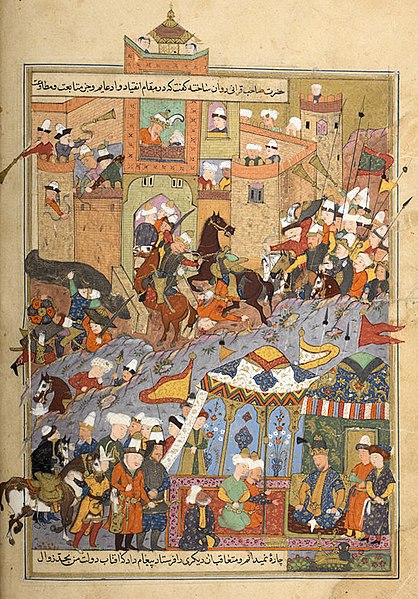Timur, also known as Tamerlane, was a Turco-Mongol conqueror who founded the Timurid Empire in and around modern-day Afghanistan, Iran, and Central Asia, becoming the first ruler of the Timurid dynasty. An undefeated commander, he is widely regarded as one of the greatest military leaders and tacticians in history, as well as one of the most brutal and deadly. Timur is also considered a great patron of art and architecture as he interacted with intellectuals such as Ibn Khaldun, Hafez, and Hafiz-i Abru and his reign introduced the Timurid Renaissance.
Timur facial reconstruction from skull, by Mikhail Mikhaylovich Gerasimov
Depiction of Timur granting audience on the occasion of his accession, in the near-contemporary Zafarnama (1424–1428), 1467 edition
Timur commanding the Siege of Balkh
Timur enthroned at Balkh
The Timurid Empire was a late medieval, culturally Persianate Turco-Mongol empire that dominated Greater Iran in the early 15th century, comprising modern-day Iran, Iraq, Afghanistan, much of Central Asia, the South Caucasus, as well as parts of contemporary Pakistan, North India and Turkey. The empire was culturally hybrid, combining Turko-Mongolian and Persianate influences, with the last members of the dynasty being "regarded as ideal Perso-Islamic rulers".
Depiction of Timur granting audience on the occasion of his accession, in the near-contemporary Zafarnama (1424-1428), 1467 edition
Timur receiving Amir Husayn's envoy during his attack on Balkh (1370). Miniature painting from Mirkhvand's Rawzat al-Safa (Turkey, 1599).
Forensic facial reconstruction of Turco-Mongol conqueror Timur from his skull, performed by the Soviet archaeologist and anthropologist Mikhail Mikhaylovich Gerasimov (1941)
Folio of Poetry From the Divan of Sultan Husayn Mirza, c. 1490. Brooklyn Museum.





